Managing behavioral health data shouldn’t mean choosing between compliance and clinical voice. Discover how a modern EHR like blueBriX helps multi-location organizations document flexibly, stay audit-ready, and reduce administrative burnout.

Your providers didn’t train to become compliance experts — they just want tools that support care without slowing them down. As a leader in the US behavioral health sector, you’re likely familiar with the intricate web of regulations, diverse reporting requirements, and the constant need to capture a wide array of patient data. Managing multi-location facilities, catering to various specialties, and accommodating the unique documentation styles of numerous providers can feel like a tightrope walk. You need a behavioral health EHR that not only keeps you compliant but also empowers your team and enhances patient care, without adding to the administrative burden.
Did you know? Behavioral health organizations lose an average of $150,000 annually due to billing errors tied to inconsistent documentation practices. That’s not just revenue lost—it’s time, trust, and treatment impact slipping through the cracks.
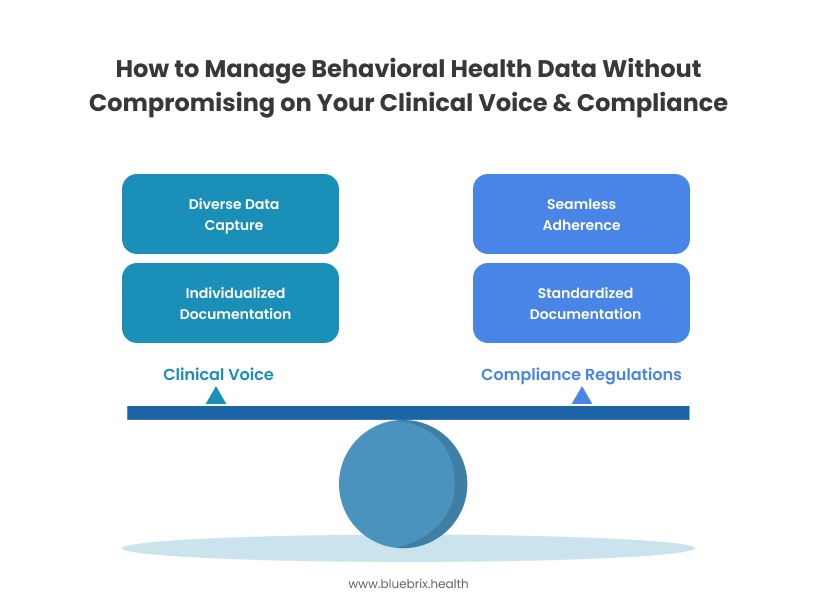
The good news? The right behavioral health EHR can be your anchor in this complex landscape, providing the flexibility you need for data capture while ensuring ironclad compliance. Let’s delve into how a modern, adaptable EHR can address these challenges head-on.
Behavioral Health Documentation: Striking the Balance Between Compliance and Clinical Voice
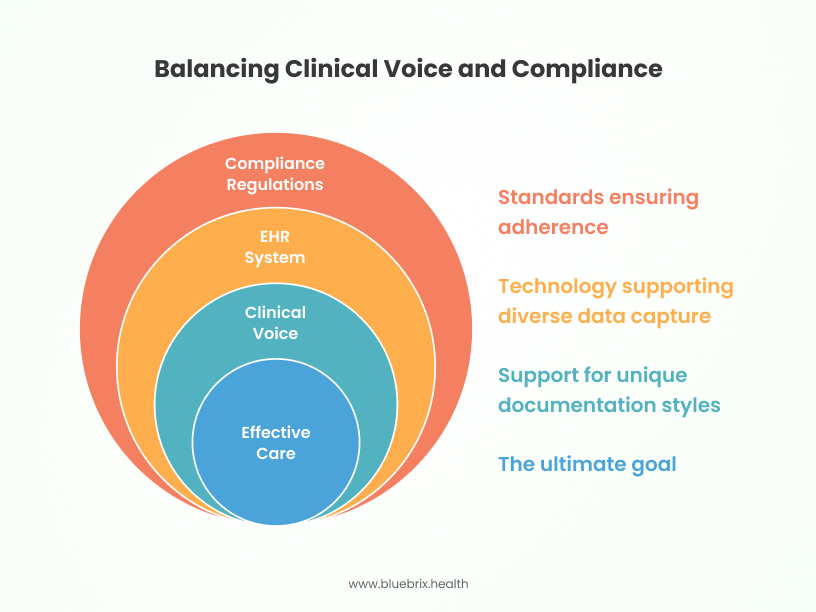
Your providers are the heart of your organization, and their clinical voice – their unique way of documenting patient interactions, observations, and progress – is crucial for effective care. However, this individuality must exist within the framework of stringent compliance regulations from various payers, states, and the federal government. The ideal behavioral health EHR helps you strike this delicate balance, supporting diverse data capture methods while seamlessly ensuring adherence to all necessary standards.
blueBriX insight: Our intelligent form builder captures every required field without restricting how your providers express care, bridging compliance with clinical freedom.
The Challenge of Diverse Data Capture Needs: One Size Doesn’t Fit All
In behavioral health, how data enters the system is as important as what data enters. You may have therapists dictating notes, case managers completing checklists, and intake staff scanning assessments.
Real-world example: A mid-sized behavioral health group using rigid EHR templates reported a 23% drop in documentation timeliness across providers. After switching to a customizable solution, timely entries rebounded by 31% in just three months.
- Supporting Multiple Styles of Documentation: Some providers may prefer detailed narrative notes, while others rely on structured templates or checklists. Your EHR should accommodate these different styles without compromising data integrity or compliance.
- Accommodating Various Methods: Data isn’t always entered directly into a computer. Your system should support physical notes that can be easily transcribed or scanned, online forms completed by patients or referring providers, and real-time data entry during sessions.
- Integrating Data from Medical Devices: For organizations offering integrated physical and behavioral healthcare, the ability to incorporate data from medical devices is increasingly important.
- Capturing Information from Phone Calls and Scribes: Documenting phone consultations or utilizing scribes for real-time note-taking requires flexible data capture options within your behavioral health EHR.
The Power of a Unified System: Flexibility Without Fragmentation
The key to managing this complexity lies in a unified behavioral health EHR platform. Instead of disparate systems that don’t communicate effectively, a centralized EHR acts as a single source of truth, capable of handling multiple data capture methods while maintaining data consistency and facilitating seamless information sharing among authorized users.
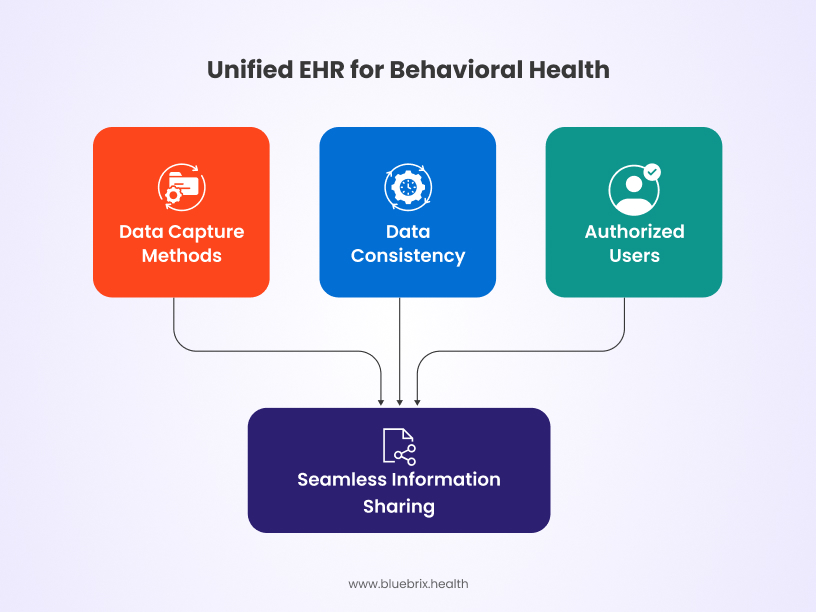
If you’re juggling 3+ disconnected systems, you’re not only spending more but increasing the likelihood of audit flags, missed care gaps, and frustrated staff. What could integration save you?
Ensuring Compliance Across Varied Regulations: A Non-Negotiable Imperative
Compliance isn’t just paperwork—it’s personal. But between HIPAA, 42 CFR Part 2, and varying state-level rules, it’s no wonder compliance often feels like a full-time job.
Compliance isn’t just a box to be ticked; it’s fundamental to the sustainability and ethical operation of your behavioral health organization. Every state has its own regulatory flavor. Add to that the demands of Medicaid, commercial payers, HIPAA, and 42 CFR Part 2—and compliance can become overwhelming.
According to a 2023 MGMA study, 72% of behavioral health administrators cite compliance tracking as their most time-consuming back-office task.
Your behavioral health EHR must be equipped to handle the ever-evolving requirements of:
- Different Payer Requirements: Each insurance provider may have specific documentation and reporting guidelines. Your EHR should allow you to customize documentation and generate reports that meet these individual needs.
- Meeting State-Specific Regulations: Behavioral health regulations can vary significantly from state to state. Your EHR vendor should understand these nuances and provide tools to ensure compliance within each of your service areas.
- Adhering to Federal Guidelines: HIPAA, 42 CFR Part 2, and other federal regulations require robust security, privacy controls, and specific data handling procedures. Your EHR must be compliant with these overarching standards.
Centralized Reporting for Complex Organizations: Clarity Amidst Complexity
For organizations with multiple locations, diverse specialties (e.g., mental health, substance use disorder treatment), and numerous providers, generating comprehensive and accurate reports can be a significant challenge. Your leadership team needs clean, complete, and configurable reports—without sifting through multiple systems.
blueBriX in action: A large outpatient behavioral health network consolidated reporting across 12 locations using blueBriX dashboards. Result: Compliance review time dropped from 18 hours/month to under 3 hours.
A robust behavioral health EHR offers centralized reporting capabilities that allow you to:
- Manage Multi-Location Facilities: Consolidate data from all your sites into a single reporting platform, providing a holistic view of your organization’s performance and compliance.
- Handling Documentation Across Multi-Specialties: Customize reporting parameters to analyze data specific to each of your service lines while also providing an integrated overview.
- Facilitating Diverse Provider Documentation Styles: Ensure that regardless of individual documentation preferences, the underlying data structure allows for consistent and compliant reporting.
Key Features of a Flexible and Compliant Behavioral Health EHR: Built for Your Needs
What a Compliance-Ready, Clinician-Friendly EHR Should Deliver?
- Support narrative + structured documentation
- Accommodate federal, state, and payer compliance rules
- Centralize data across multi-location networks
- Provide real-time dashboards and reports
A modern behavioral health EHR designed to tackle these complex issues will offer a range of crucial features:
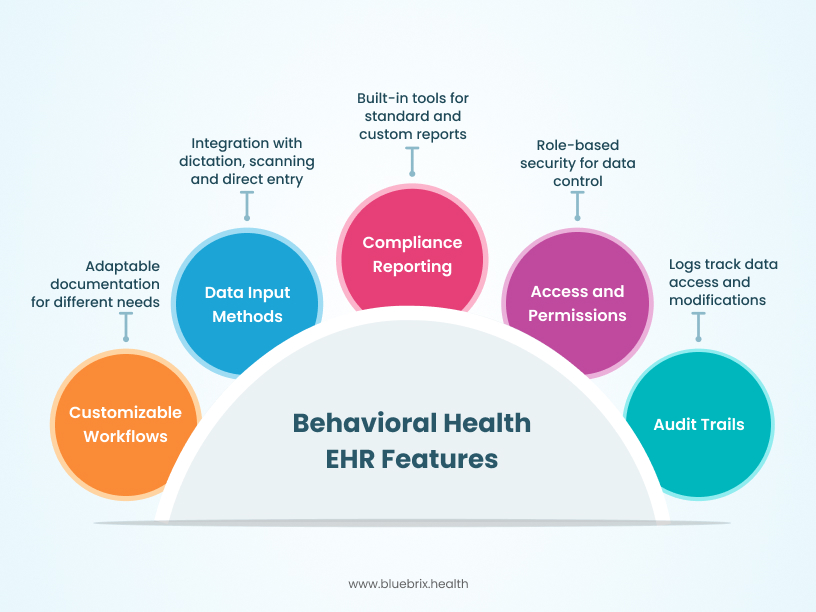
- Customizable Workflows and Templates: The ability to create and adapt documentation templates to suit different provider styles, treatment modalities, and payer requirements is essential.
- Support for Various Data Input Methods: Seamless integration with dictation software, the ability to upload scanned documents, and user-friendly interfaces for direct data entry are crucial for accommodating diverse data capture needs.
- Integrated Compliance Reporting Tools: Look for an EHR that includes built-in tools to generate standard compliance reports for various payers and regulatory bodies, as well as the ability to create custom reports as needed.
- Role-Based Access and Permissions: Robust security features that allow you to control who can access and modify patient data are vital for HIPAA compliance and protecting patient privacy.
- Audit Trails and Data Security: Comprehensive audit logs that track all data access and modifications, along with strong encryption and security protocols, are non-negotiable for compliance.
Benefits for Larger Organizations: Streamlining Operations, Ensuring Compliance, and Empowering Providers
Implementing a behavioral health EHR with the flexibility to handle diverse data capture and the robustness to ensure comprehensive compliance offers significant advantages for larger organizations.
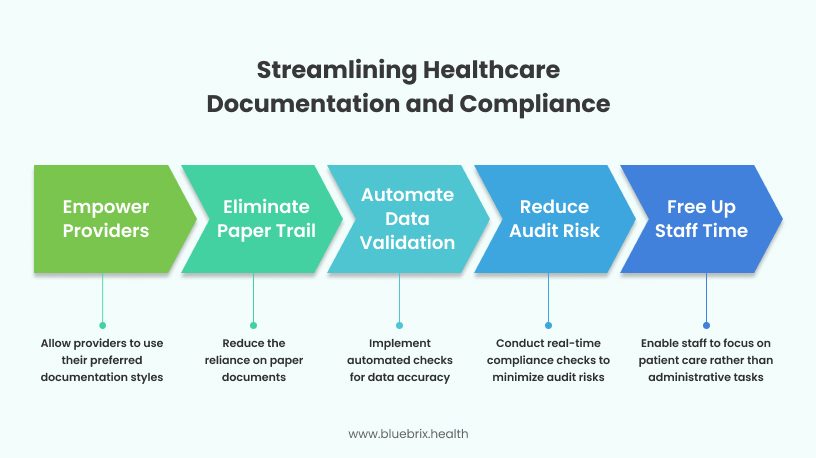
- Empowering Providers with Their Preferred Documentation Style: By accommodating individual preferences, you can reduce provider frustration and improve the quality and timeliness of documentation.
- Reducing the Risk of Misplaced or Inconsistent Progress Notes: A centralized EHR eliminates the challenges of managing paper records and ensures that all patient information is securely stored and easily accessible to authorized personnel.
- Streamlining Reporting Across Multiple Sites and Specialties: Centralized data and reporting tools simplify the process of generating accurate and comprehensive reports for all your locations and service lines, saving time and resources.
- Improving Data Accuracy and Completeness: Flexible data capture options, coupled with built-in validation rules, can enhance the accuracy and completeness of your patient records, leading to better clinical decision-making and more accurate reporting.
- Enhancing Efficiency and Reducing Administrative Burden: By streamlining documentation and reporting processes, your staff can spend less time on administrative tasks and more time on direct patient care.
Navigating Complexity with Confidence: The blueBriX Advantage
Imagine a behavioral health EHR that understands the unique complexities of your organization – a system like blueBriX. Purpose-built for whole-person care, blueBriX is designed to streamline workflows from intake to clinical care to billing, all within one integrated platform.
blueBriX recognizes that your providers have different ways of working and that compliance is paramount. Its versatile form builder allows you to create custom documentation templates that cater to various clinical approaches and payer requirements. Whether a provider prefers detailed notes, structured assessments, or a combination of both, blueBriX can accommodate their style while ensuring that all necessary data points for compliance are captured.
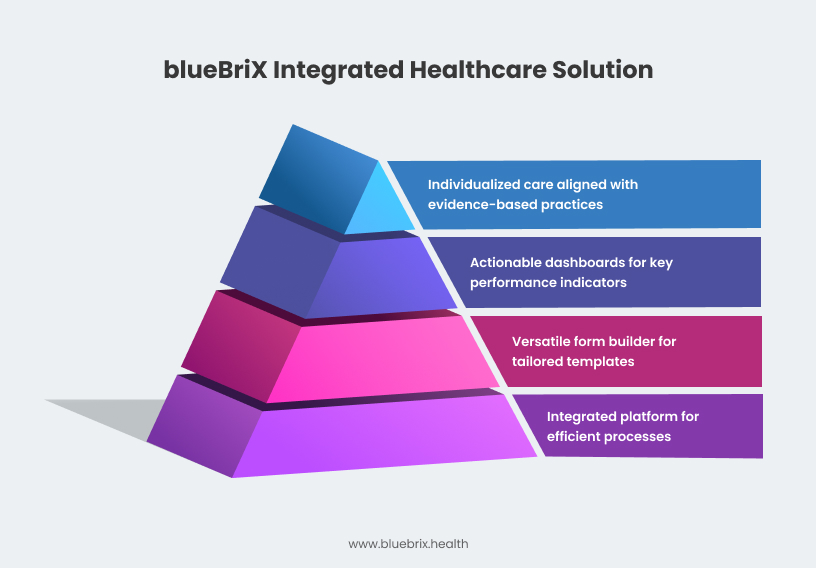
Furthermore, blueBriX offers custom actionable dashboards that provide real-time visibility into key performance indicators, including compliance metrics. These dashboards empower you to monitor adherence to regulations across all your facilities and specialties, identify potential issues proactively, and make data-driven decisions to improve outcomes and financial performance.
Flexible treatment plans within blueBriX allow for individualized care while ensuring that documentation aligns with evidence-based practices and payer guidelines. This adaptability is crucial for organizations serving diverse populations with varying needs.
Conclusion
By choosing an integrated, purpose-built behavioral health EHR like blueBriX, you’re not just adopting software; you’re investing in a solution that understands the nuances of behavioral healthcare and provides the tools you need to navigate the complexities of compliance and data capture with confidence.
The good news? The right behavioral health EHR can be your anchor in this complex landscape, providing the flexibility you need for data capture while ensuring ironclad compliance.
Let’s delve into how a modern, adaptable EHR can address these challenges head-on.